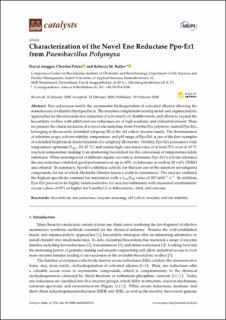Please use this identifier to cite or link to this item:
https://doi.org/10.21256/zhaw-19537| Publication type: | Article in scientific journal |
| Type of review: | Peer review (publication) |
| Title: | Characterization of the novel ene reductase Ppo-Er1 from paenibacillus polymyxa |
| Authors: | Aregger, David Peters, Christin Buller, Rebecca |
| et. al: | No |
| DOI: | 10.3390/catal10020254 10.21256/zhaw-19537 |
| Published in: | Catalysts |
| Volume(Issue): | 10 |
| Issue: | 2 |
| Issue Date: | Feb-2020 |
| Publisher / Ed. Institution: | MDPI |
| ISSN: | 2073-4344 |
| Language: | English |
| Subject (DDC): | 660.6: Biotechnology |
| Abstract: | Ene reductases enable the asymmetric hydrogenation of activated alkenes allowing the manufacture of valuable chiral products. The enzymes complement existing metal- and organocatalytic approaches for the stereoselective reduction of activated C=C double bonds, and efforts to expand the biocatalytic toolbox with additional ene reductases are of high academic and industrial interest. Here, we present the characterization of a novel ene reductase from Paenibacillus polymyxa, named Ppo-Er1, belonging to the recently identified subgroup III of the old yellow enzyme family. The determination of substrate scope, solvent stability, temperature, and pH range of Ppo-Er1 is one of the first examples of a detailed biophysical characterization of a subgroup III enzyme. Notably, Ppo-Er1 possesses a wide temperature optimum (Topt: 20–45 °C) and retains high conversion rates of at least 70% even at 10 °C reaction temperature making it an interesting biocatalyst for the conversion of temperature-labile substrates. When assaying a set of different organic solvents to determine Ppo-Er1′s solvent tolerance, the ene reductase exhibited good performance in up to 40% cyclohexane as well as 20 vol% DMSO and ethanol. In summary, Ppo-Er1 exhibited activity for thirteen out of the nineteen investigated compounds, for ten of which Michaelis–Menten kinetics could be determined. The enzyme exhibited the highest specificity constant for maleimide with a kcat/KM value of 287 mM−1 s−1. In addition, Ppo-Er1 proved to be highly enantioselective for selected substrates with measured enantiomeric excess values of 92% or higher for 2-methyl-2-cyclohexenone, citral, and carvone. |
| URI: | https://digitalcollection.zhaw.ch/handle/11475/19537 |
| Fulltext version: | Published version |
| License (according to publishing contract): | CC BY 4.0: Attribution 4.0 International |
| Departement: | Life Sciences and Facility Management |
| Organisational Unit: | Institute of Chemistry and Biotechnology (ICBT) |
| Appears in collections: | Publikationen Life Sciences und Facility Management |
Files in This Item:
| File | Description | Size | Format | |
|---|---|---|---|---|
| 2020_Aregger_Characterization_of_the_Novel_Ene_Reductase_MDPI.pdf | 1.23 MB | Adobe PDF |  View/Open |
Show full item record
Aregger, D., Peters, C., & Buller, R. (2020). Characterization of the novel ene reductase Ppo-Er1 from paenibacillus polymyxa. Catalysts, 10(2). https://doi.org/10.3390/catal10020254
Aregger, D., Peters, C. and Buller, R. (2020) ‘Characterization of the novel ene reductase Ppo-Er1 from paenibacillus polymyxa’, Catalysts, 10(2). Available at: https://doi.org/10.3390/catal10020254.
D. Aregger, C. Peters, and R. Buller, “Characterization of the novel ene reductase Ppo-Er1 from paenibacillus polymyxa,” Catalysts, vol. 10, no. 2, Feb. 2020, doi: 10.3390/catal10020254.
AREGGER, David, Christin PETERS und Rebecca BULLER, 2020. Characterization of the novel ene reductase Ppo-Er1 from paenibacillus polymyxa. Catalysts. Februar 2020. Bd. 10, Nr. 2. DOI 10.3390/catal10020254
Aregger, David, Christin Peters, and Rebecca Buller. 2020. “Characterization of the Novel Ene Reductase Ppo-Er1 from Paenibacillus Polymyxa.” Catalysts 10 (2). https://doi.org/10.3390/catal10020254.
Aregger, David, et al. “Characterization of the Novel Ene Reductase Ppo-Er1 from Paenibacillus Polymyxa.” Catalysts, vol. 10, no. 2, Feb. 2020, https://doi.org/10.3390/catal10020254.
Items in DSpace are protected by copyright, with all rights reserved, unless otherwise indicated.